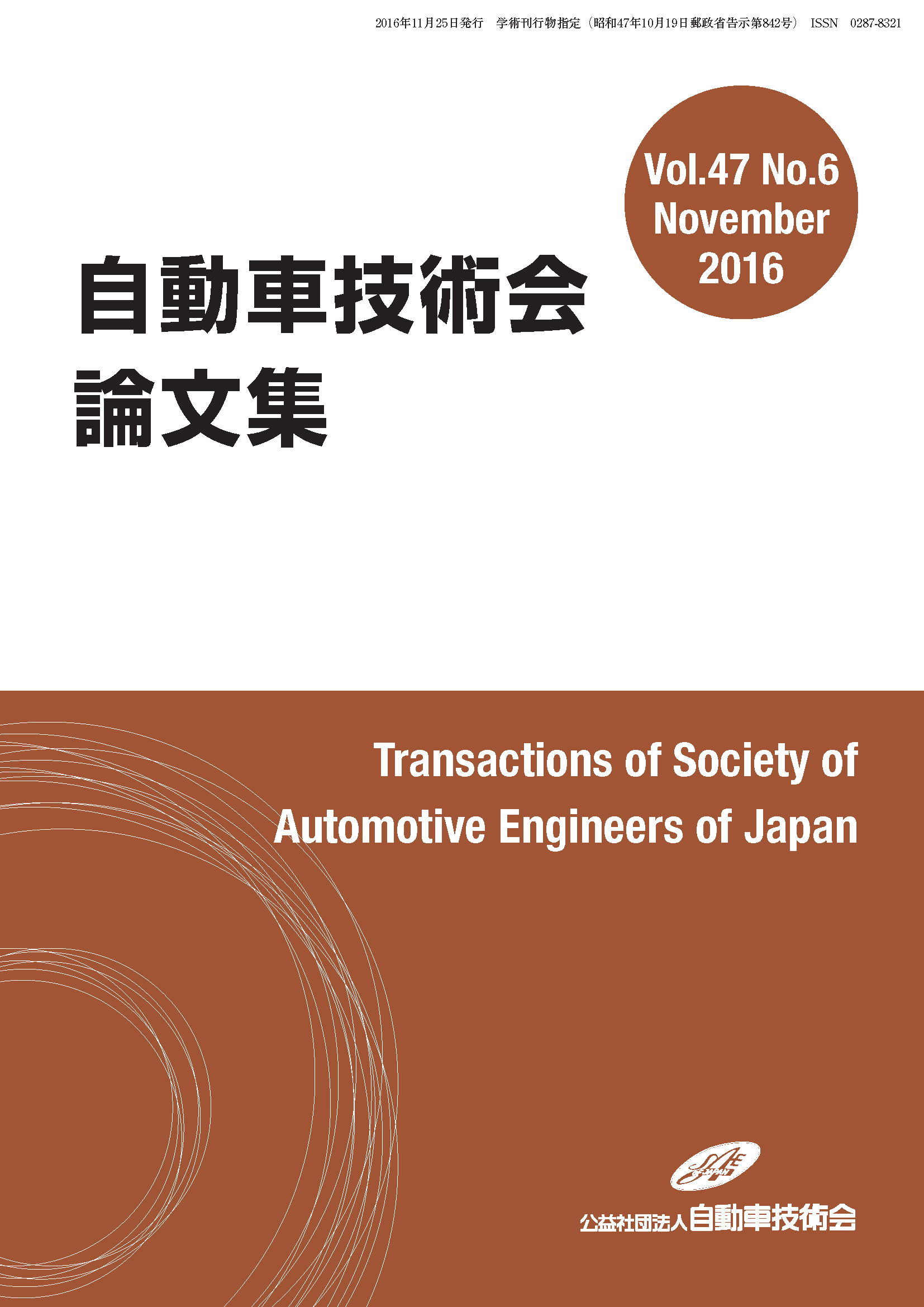Volume 47, Issue 6
Displaying 1-41 of 41 articles from this issue
- |<
- <
- 1
- >
- >|
Technical Paper
-
2016Volume 47Issue 6 Pages 1215-1220
Published: 2016
Released on J-STAGE: January 29, 2018
Download PDF (2923K)
Research Paper
-
2016Volume 47Issue 6 Pages 1221-1227
Published: 2016
Released on J-STAGE: January 29, 2018
Download PDF (2433K) -
2016Volume 47Issue 6 Pages 1229-1234
Published: 2016
Released on J-STAGE: January 29, 2018
Download PDF (1902K) -
2016Volume 47Issue 6 Pages 1235-1240
Published: 2016
Released on J-STAGE: January 29, 2018
Download PDF (1469K) -
2016Volume 47Issue 6 Pages 1241-1245
Published: 2016
Released on J-STAGE: January 29, 2018
Download PDF (1764K) -
2016Volume 47Issue 6 Pages 1247-1251
Published: 2016
Released on J-STAGE: January 29, 2018
Download PDF (937K) -
2016Volume 47Issue 6 Pages 1253-1258
Published: 2016
Released on J-STAGE: January 29, 2018
Download PDF (1953K) -
2016Volume 47Issue 6 Pages 1259-1264
Published: 2016
Released on J-STAGE: January 29, 2018
Download PDF (2823K) -
2016Volume 47Issue 6 Pages 1265-1270
Published: 2016
Released on J-STAGE: January 29, 2018
Download PDF (6765K) -
2016Volume 47Issue 6 Pages 1271-1277
Published: 2016
Released on J-STAGE: January 29, 2018
Download PDF (2396K)
Technical Paper
-
2016Volume 47Issue 6 Pages 1279-1284
Published: 2016
Released on J-STAGE: January 29, 2018
Download PDF (3789K)
Research Paper
-
Specifications Impact of Diesel Oxidation Catalyst on White Smoke Emission Derived from Hydrocarbons2016Volume 47Issue 6 Pages 1285-1290
Published: 2016
Released on J-STAGE: January 29, 2018
Download PDF (3068K) -
2016Volume 47Issue 6 Pages 1291-1296
Published: 2016
Released on J-STAGE: January 29, 2018
Download PDF (2048K) -
2016Volume 47Issue 6 Pages 1297-1303
Published: 2016
Released on J-STAGE: January 29, 2018
Download PDF (2001K) -
2016Volume 47Issue 6 Pages 1305-1310
Published: 2016
Released on J-STAGE: January 29, 2018
Download PDF (1865K) -
2016Volume 47Issue 6 Pages 1311-1316
Published: 2016
Released on J-STAGE: January 29, 2018
Download PDF (2368K)
Technical Paper
-
2016Volume 47Issue 6 Pages 1317-1322
Published: 2016
Released on J-STAGE: January 29, 2018
Download PDF (2812K)
Research Paper
-
2016Volume 47Issue 6 Pages 1323-1327
Published: 2016
Released on J-STAGE: January 29, 2018
Download PDF (1460K) -
2016Volume 47Issue 6 Pages 1329-1335
Published: 2016
Released on J-STAGE: January 29, 2018
Download PDF (887K) -
2016Volume 47Issue 6 Pages 1337-1342
Published: 2016
Released on J-STAGE: January 29, 2018
Download PDF (2052K)
Technical Paper
-
2016Volume 47Issue 6 Pages 1343-1348
Published: 2016
Released on J-STAGE: January 29, 2018
Download PDF (3007K)
Research Paper
-
2016Volume 47Issue 6 Pages 1349-1353
Published: 2016
Released on J-STAGE: January 29, 2018
Download PDF (1549K)
Technical Paper
-
2016Volume 47Issue 6 Pages 1355-1359
Published: 2016
Released on J-STAGE: January 29, 2018
Download PDF (3280K)
Research Paper
-
2016Volume 47Issue 6 Pages 1361-1366
Published: 2016
Released on J-STAGE: January 29, 2018
Download PDF (2628K) -
2016Volume 47Issue 6 Pages 1367-1372
Published: 2016
Released on J-STAGE: January 29, 2018
Download PDF (1589K) -
2016Volume 47Issue 6 Pages 1373-1379
Published: 2016
Released on J-STAGE: January 29, 2018
Download PDF (5021K) -
2016Volume 47Issue 6 Pages 1381-1386
Published: 2016
Released on J-STAGE: January 29, 2018
Download PDF (4425K)
Technical Paper
-
2016Volume 47Issue 6 Pages 1387-1392
Published: 2016
Released on J-STAGE: January 29, 2018
Download PDF (2194K)
Research Paper
-
2016Volume 47Issue 6 Pages 1393-1398
Published: 2016
Released on J-STAGE: January 29, 2018
Download PDF (3333K) -
Method of Determining Trajectory of a Dummy’s Head by Using Linear Acceleration and Angular Velocity2016Volume 47Issue 6 Pages 1399-1404
Published: 2016
Released on J-STAGE: January 29, 2018
Download PDF (2493K) -
2016Volume 47Issue 6 Pages 1405-1409
Published: 2016
Released on J-STAGE: January 29, 2018
Download PDF (2379K) -
2016Volume 47Issue 6 Pages 1411-1416
Published: 2016
Released on J-STAGE: January 29, 2018
Download PDF (2054K) -
2016Volume 47Issue 6 Pages 1417-1423
Published: 2016
Released on J-STAGE: January 29, 2018
Download PDF (2226K)
Material
-
2016Volume 47Issue 6 Pages 1425-1429
Published: 2016
Released on J-STAGE: January 29, 2018
Download PDF (1252K)
Research Paper
-
2016Volume 47Issue 6 Pages 1431-1437
Published: 2016
Released on J-STAGE: January 29, 2018
Download PDF (1421K) -
2016Volume 47Issue 6 Pages 1439-1445
Published: 2016
Released on J-STAGE: January 29, 2018
Download PDF (5885K) -
2016Volume 47Issue 6 Pages 1447-1452
Published: 2016
Released on J-STAGE: January 29, 2018
Download PDF (2846K)
Technical Paper
-
2016Volume 47Issue 6 Pages 1453-1458
Published: 2016
Released on J-STAGE: January 29, 2018
Download PDF (2830K)
Research Paper
-
2016Volume 47Issue 6 Pages 1459-1464
Published: 2016
Released on J-STAGE: January 29, 2018
Download PDF (2747K) -
2016Volume 47Issue 6 Pages 1465-1470
Published: 2016
Released on J-STAGE: January 29, 2018
Download PDF (1478K) -
2016Volume 47Issue 6 Pages 1471-1475
Published: 2016
Released on J-STAGE: January 29, 2018
Download PDF (1821K)
- |<
- <
- 1
- >
- >|
